Steak Fajita Pasta
Fajita...But Pasta
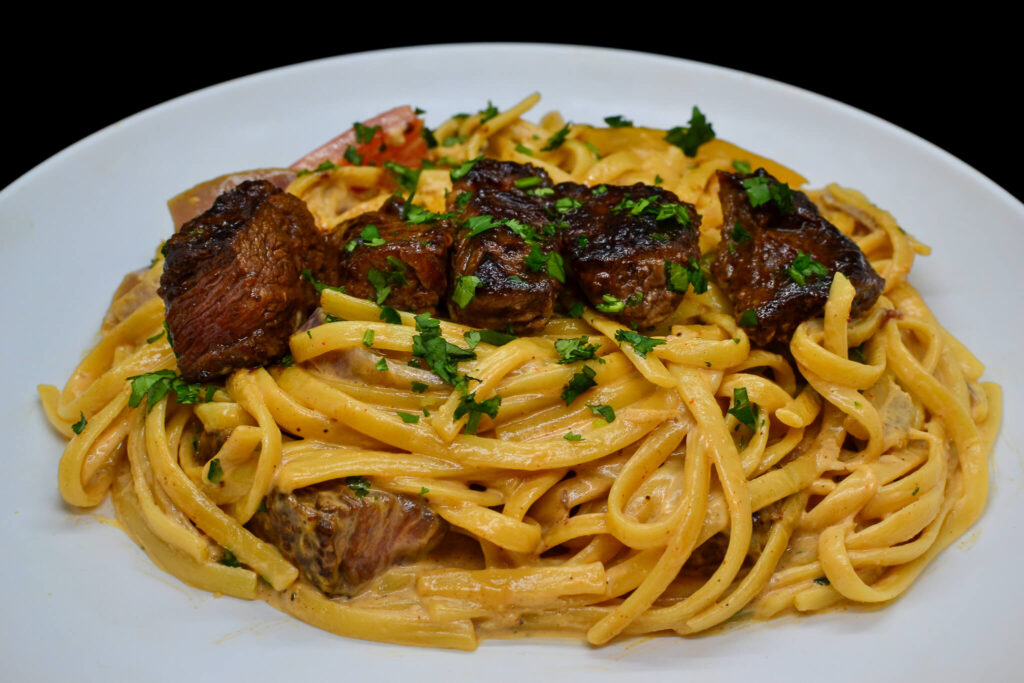
What Is Steak Fajita Pasta?
Steak fajita pasta is a dish that combines elements of Mexican and Italian cuisine. It typically includes thin slices of grilled or pan-fried steak that have been marinated in fajita spices such as chili powder, cumin, and paprika. The steak is then served with sautéed onions, peppers, and garlic, along with cooked pasta.
Ingredients For Steak Fajita Pasta
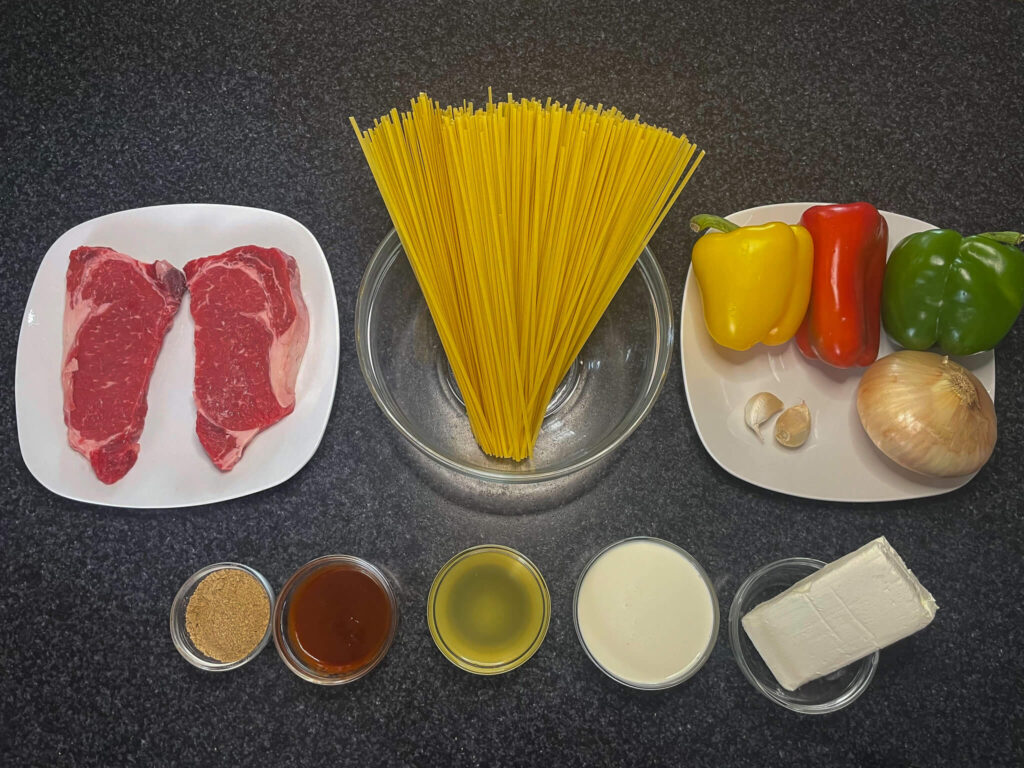

Produce
1 Green Pepper
1 Yellow Pepper
1 Red Pepper
1 Sweet Onion
2 Garlic Cloves
Refrigerated
1 Cup Heavy Cream
8 oz Cream Cheese

Grocery
7 oz Chipotle Peppers
1/2 Cup Chicken Broth
16 oz Linguine Pasta

Meat
2 Rib Eye Steaks

Spices
1 Packet Fajita Seasoning
How To Make Steak Fajita Pasta
Step 1
Prep & Cook Steak
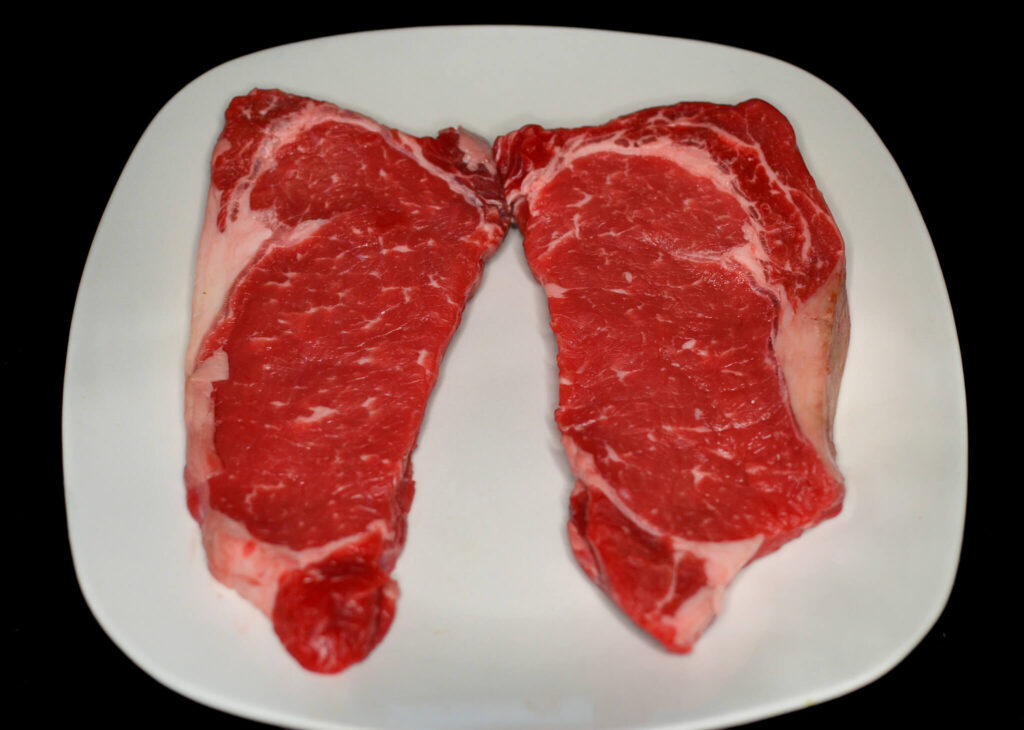
Ribeye is an excellent choice for Steak Fajita Pasta due to its rich marbling. This marbling, which is the fat within the steak, melts during cooking, making the meat juicy and flavorful. The fat adds a depth of taste that enhances the overall flavor of the pasta, ensuring every bite is both tender and delicious. Using ribeye ensures your pasta dish is not just tasty, but also rich and satisfying.
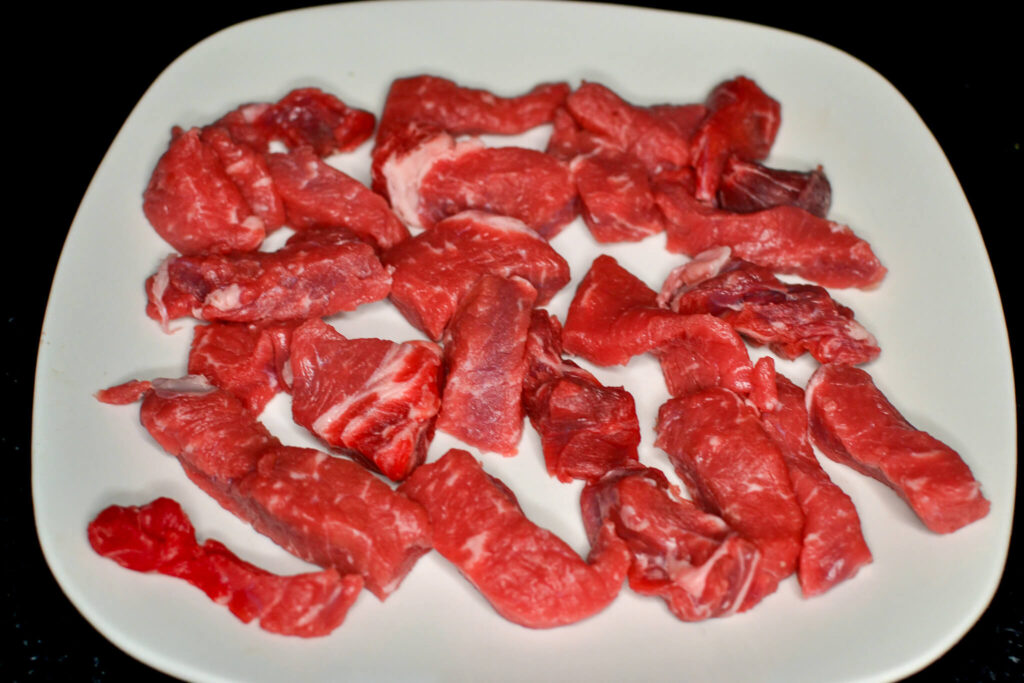
Before cooking the ribeyes, it’s important to slice them correctly. Good slicing is crucial for perfect fajitas. Aim for thin, appealing slices by cutting against the grain of the steak. This method breaks down the muscle fibers, resulting in tender meat that’s easy to chew.
While it’s not the only method, cutting the steak beforehand is a great option, especially if you’re pressed for time. It’s a convenient approach that can save a few minutes in the kitchen without compromising on the dish’s quality.
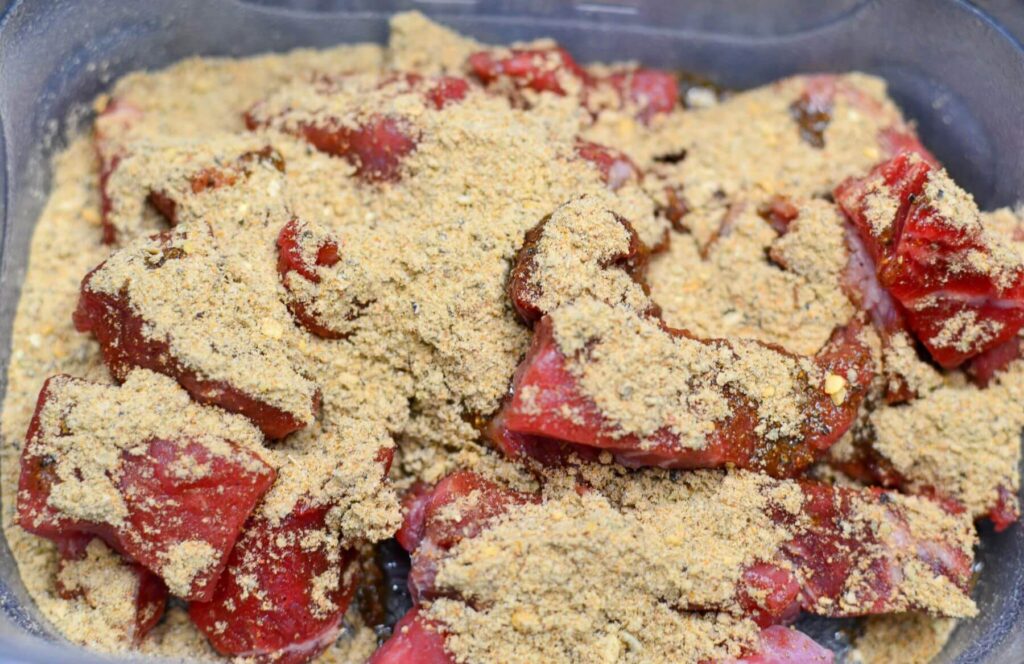
For seasoning, simplicity can be key. In this recipe, I’ve opted for a pre-mixed McCormick’s Fajita Seasoning Mix. It’s a convenient blend that’s smoky, slightly spicy, and packed with flavor. Using this mix ensures that each steak strip is evenly coated and bursting with taste. This choice not only simplifies the preparation process but also guarantees a harmonious blend of flavors that complement the pasta and vegetables beautifully.
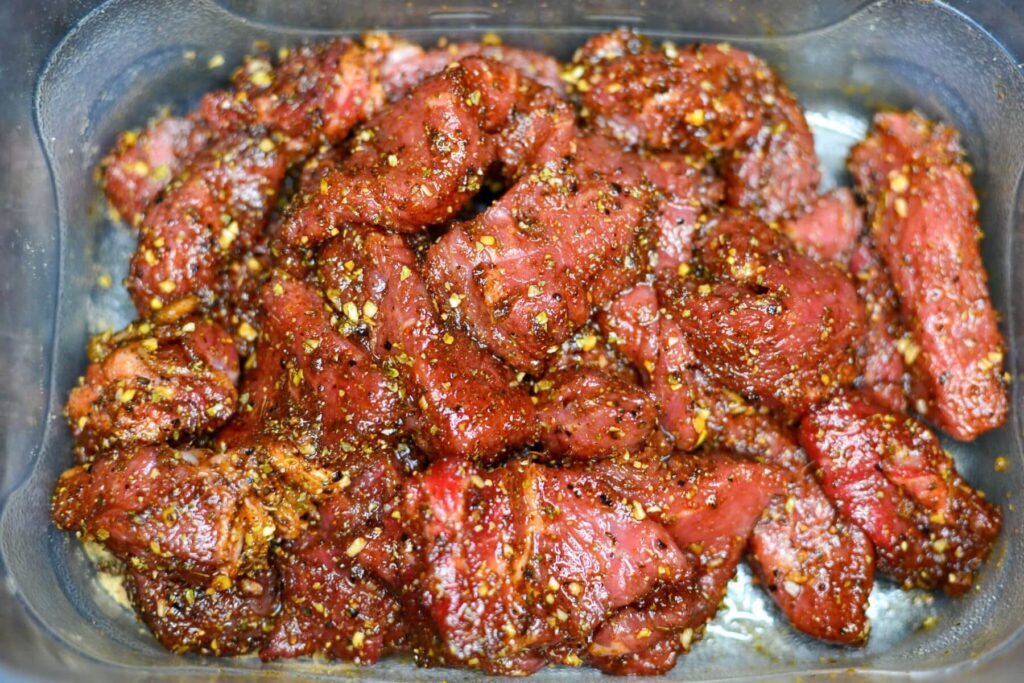
Marinating the steaks is a simple yet impactful step. Along with the McCormick fajita seasoning, I add olive oil to the marinade. The olive oil not only helps to evenly distribute the seasoning across the meat but also adds moisture, enhancing the tenderness of the steaks. A minimum of 30 minutes is great for marination, but if you have more time, letting the steaks marinate for a couple of hours can further intensify the flavors and tenderness.
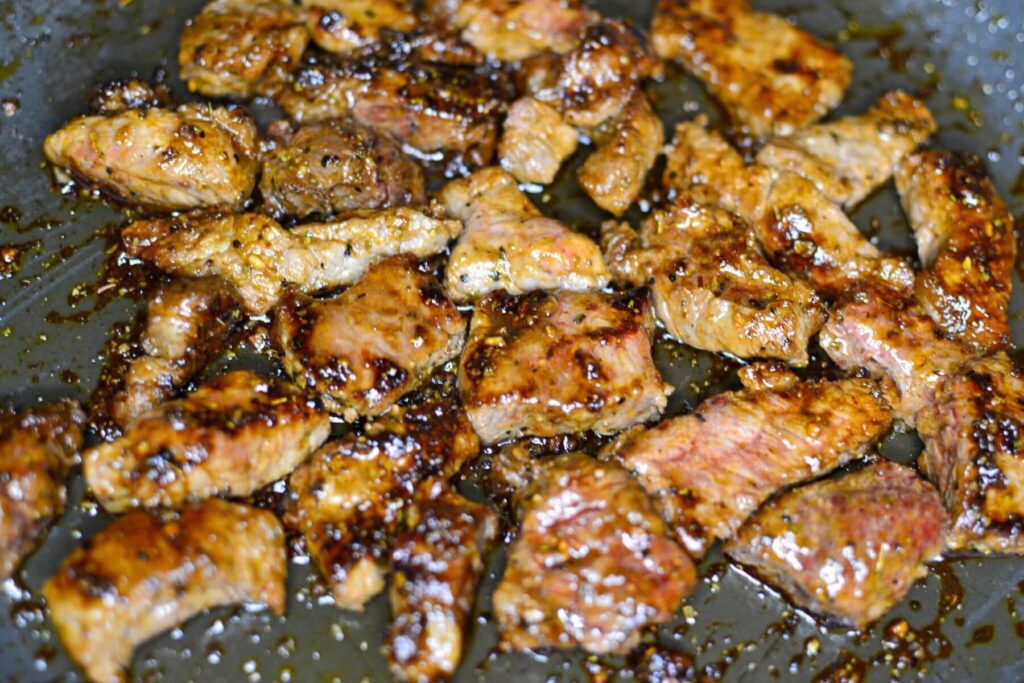
When cooking pre-cut steak strips for our fajita pasta, the approach changes slightly. Since the steaks are already sliced, they’ll cook much faster. Use a large skillet to quickly sear the strips, ensuring they brown nicely while remaining juicy inside. This rapid cooking method is ideal for achieving tender, flavorful meat without overcooking. After searing, it’s still beneficial to let them rest briefly, allowing the juices to settle and keeping the strips moist and delicious.
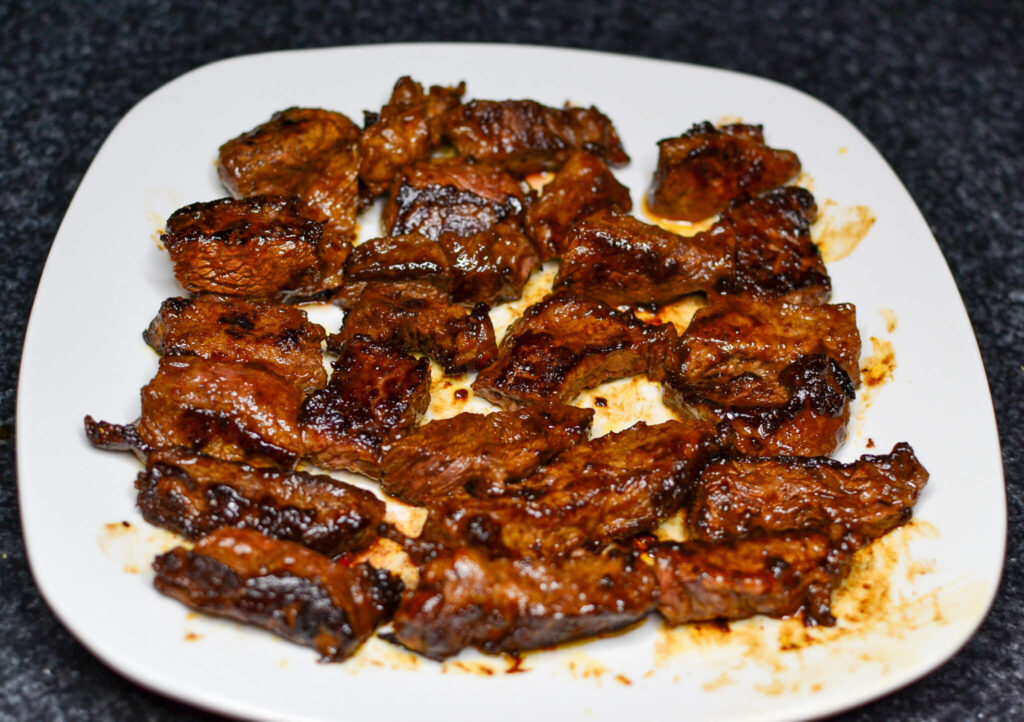
Once the steak strips are perfectly seared, take them off the heat and set them aside. This short break allows the strips to rest, ensuring they retain their juiciness. Even though they’re pre-cut, this resting period helps maintain their tenderness, making each bite succulent and flavorful.
Step 2
Prep & Cook Veggies
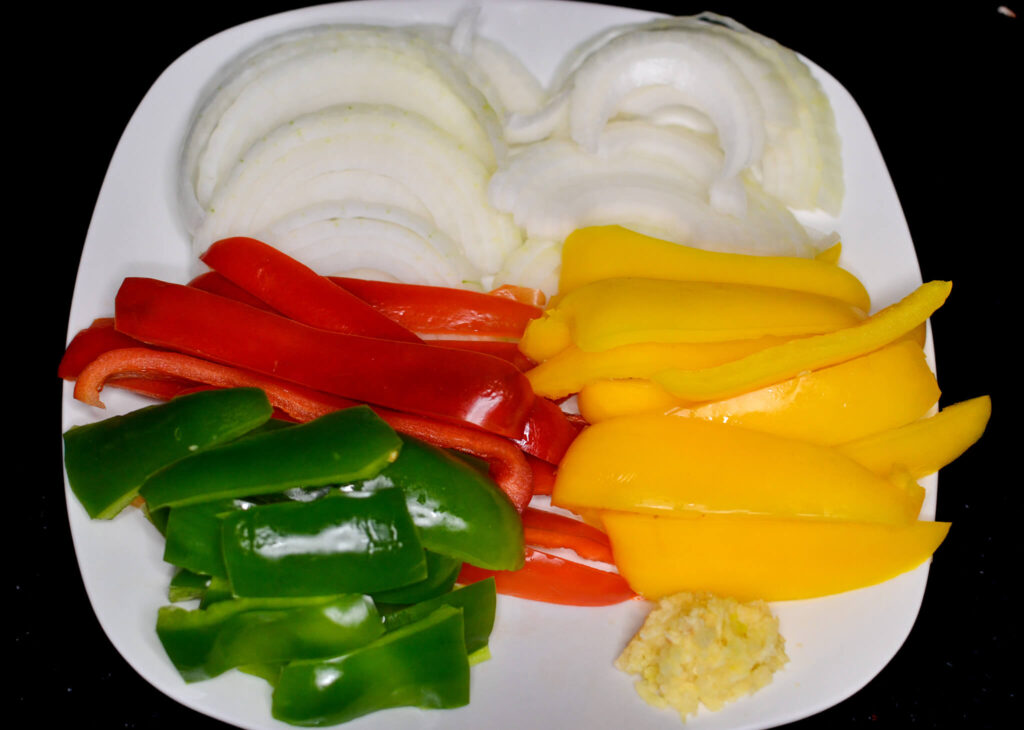
Next, we focus on the vegetables, a vital part of our fajita pasta. For this recipe, I use bell peppers and onions, slicing them into thin strips. This shape ensures that they cook evenly and blend well with the pasta, providing just the right texture and flavor in every forkful.
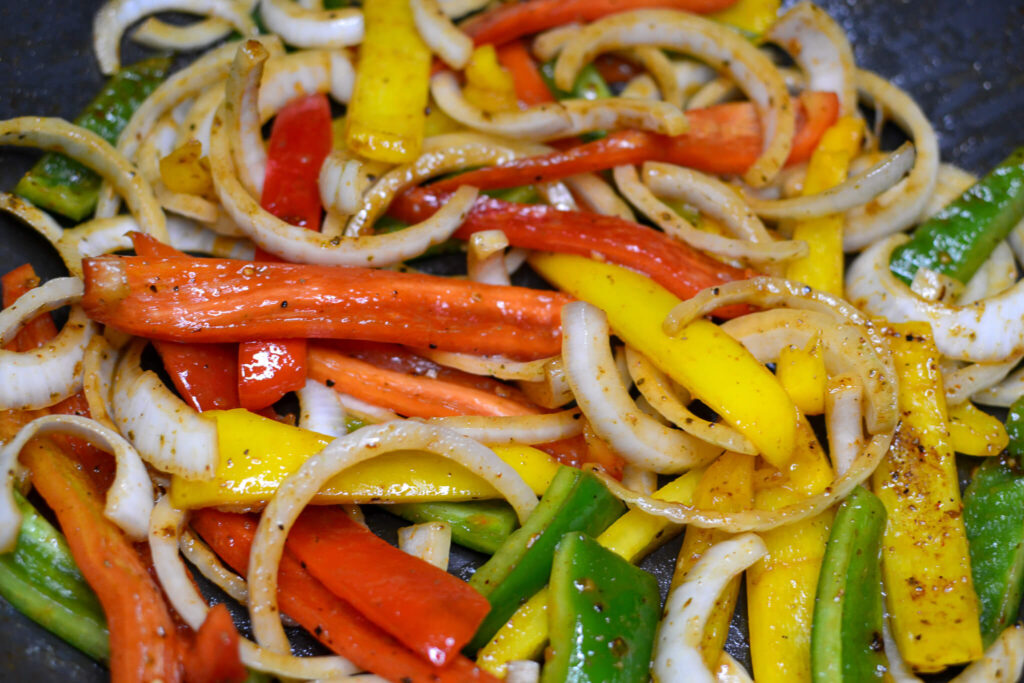
After cooking the steak, use the same pan for the peppers and onions. The leftover flavors from the steak will enhance the vegetables, adding depth to their taste. Cook them on medium high heat until they’re soft and lightly caramelized, stirring now and then. This step does more than just cook the veggies; it builds layers of flavor that will enrich the overall dish.
If you desire a stronger flavor, feel free to add more fajita seasoning. Alternatively, a simple seasoning of salt and pepper can also enhance the dish to your liking.
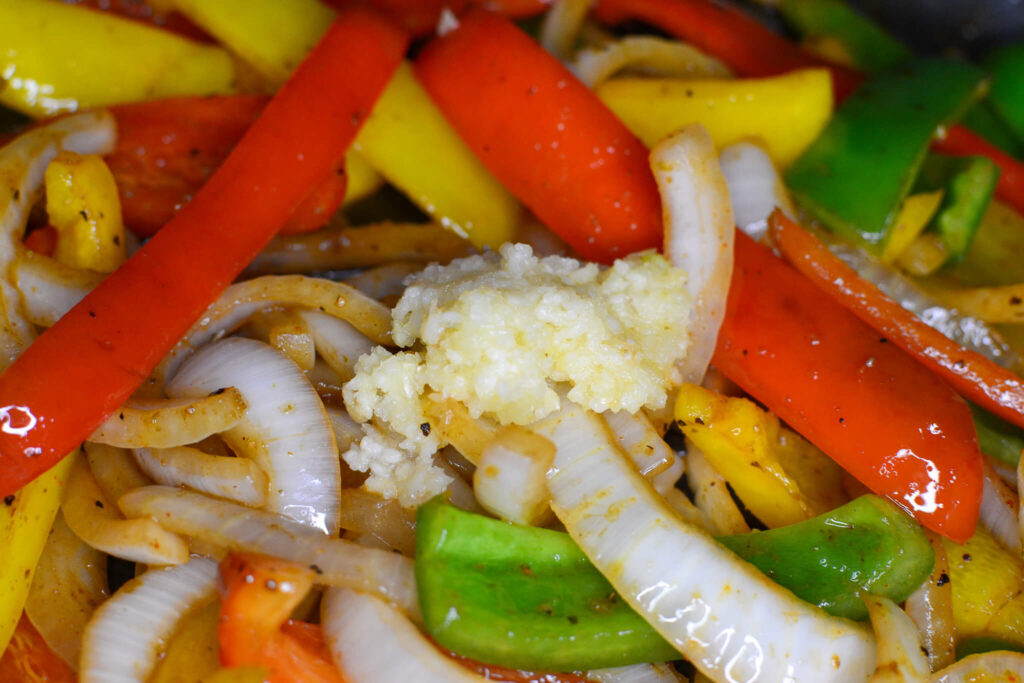
As our veggies simmer, let’s turn our attention to the pasta. Choosing the right pasta can make or break a dish. For this recipe, we want something that can hold its own against the bold flavors and textures – penne or fettuccine works wonderfully. Remember, cooking it al dente is key. It should have a slight bite to it, as it will continue to cook when we mix it with the sauce and steak.
Step 3
Cook Pasta & Make Sauce
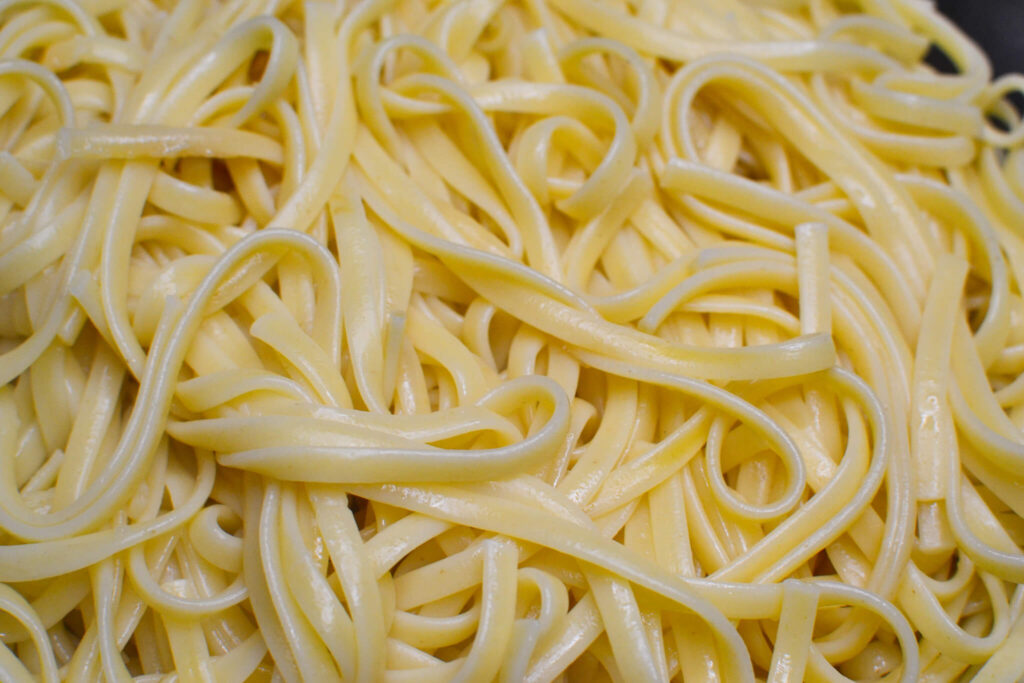
While the peppers and onions simmer away, begin boiling water for the pasta. This timing ensures that the pasta is ready to be added to the sauce as soon as it’s done. Feel free to choose any type of pasta you prefer. I personally favor linguine for this recipe, so that’s what I’ll be using.
Remember to cook the pasta according to the package instructions, which will vary depending on the type you’ve selected.
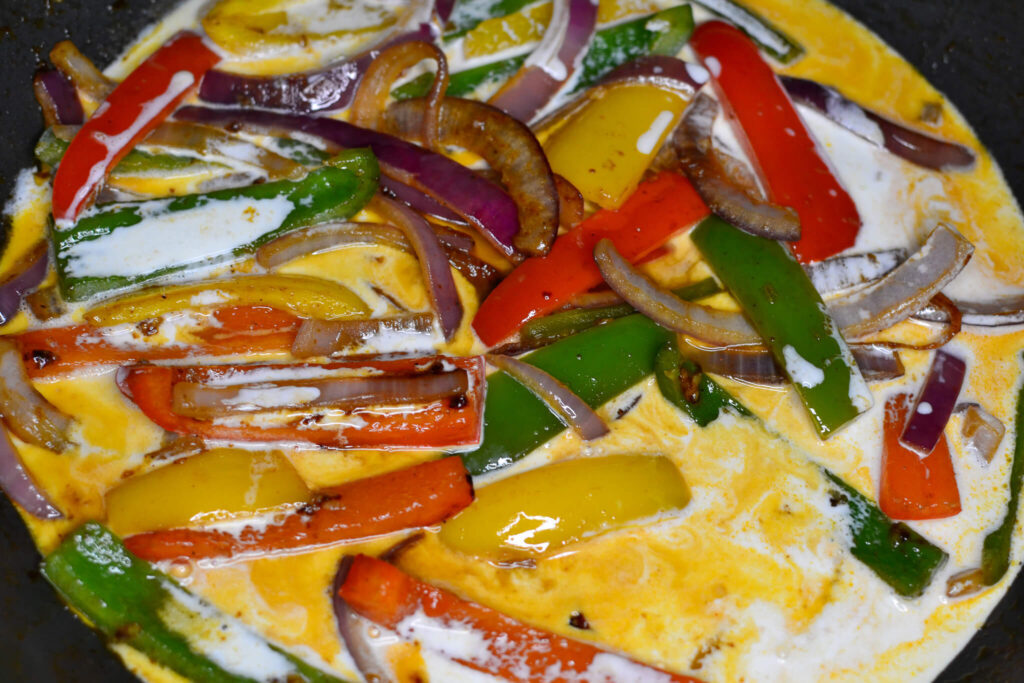
The foundation of our sauce begins in the very pan where we cooked our steak and veggies. Start by pouring in some broth, which will help deglaze the pan. As you gently scrape the bottom, all the delicious, caramelized bits from the steak and vegetables will mix with the broth, creating a rich and flavorful base. This process not only cleans your pan but also ensures that all the savory flavors are incorporated into the sauce, setting the stage for a truly delectable blend.
After deglazing the pan with broth, it’s time to enhance the sauce with richness and creaminess. The first step is to pour in the heavy cream. This ingredient is key to transforming the sauce, adding a luxurious richness that elevates the dish. As you stir the heavy cream into the mixture, you’ll notice the sauce beginning to take on a more robust and creamy texture. The heavy cream not only enriches the sauce but also ensures it’s not too heavy, striking the perfect balance to complement the other elements of the dish.
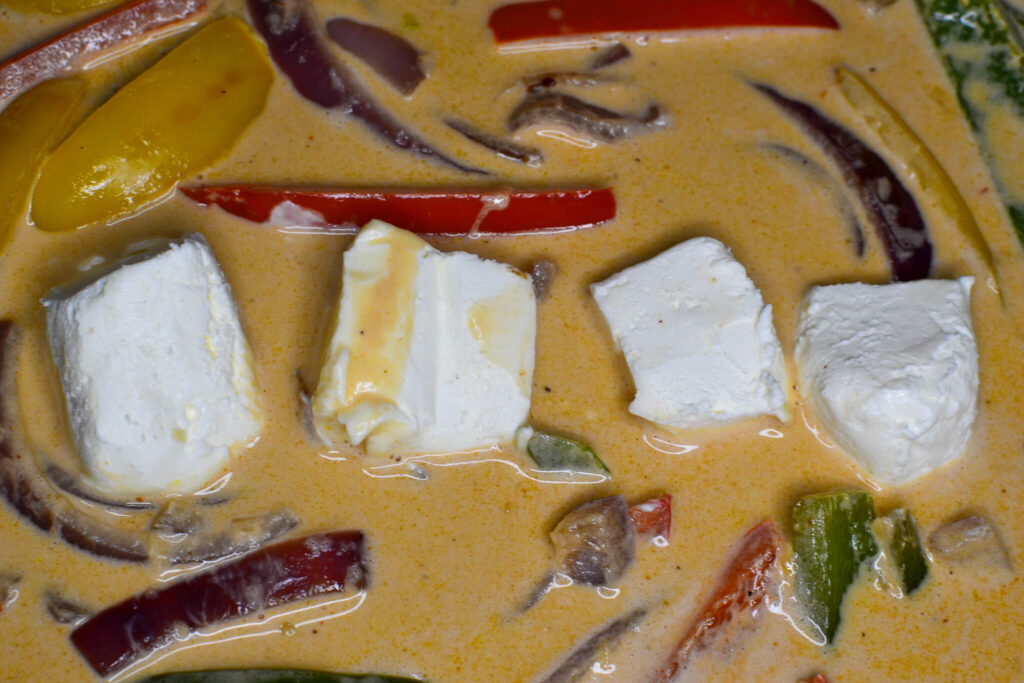
Next, introduce cream cheese into the sauce. This ingredient is essential for achieving the smooth, velvety texture that makes this dish so indulgent. Gently stir the cream cheese over a low heat, allowing it to melt and blend seamlessly with the heavy cream. This combination creates a creamy base that beautifully coats each strand of pasta. The addition of cream cheese doesn’t just add texture; it also harmonizes with the robust flavors of the steak and vegetables, ensuring each bite is a delightful fusion of taste and smoothness.
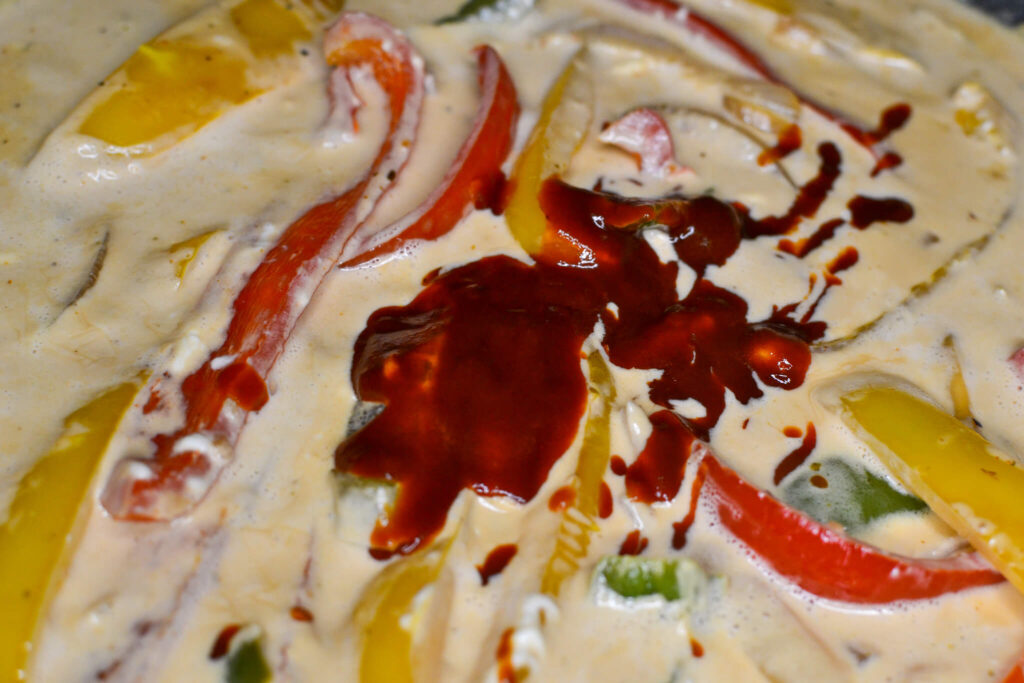
Finally, to give our sauce a unique twist, add a touch of chipotle adobo sauce using Goya Chipotle Peppers. This ingredient introduces a smoky depth and a hint of spice, elevating the sauce from simple creaminess to a more complex, intriguing flavor profile. The chipotle’s smoky notes are a perfect match for the charred flavors of the steak, while its mild heat adds an extra layer of taste without overwhelming the dish. The result is a balanced, creamy sauce that perfectly ties together the pasta and steak, making each bite a harmonious blend of flavors.
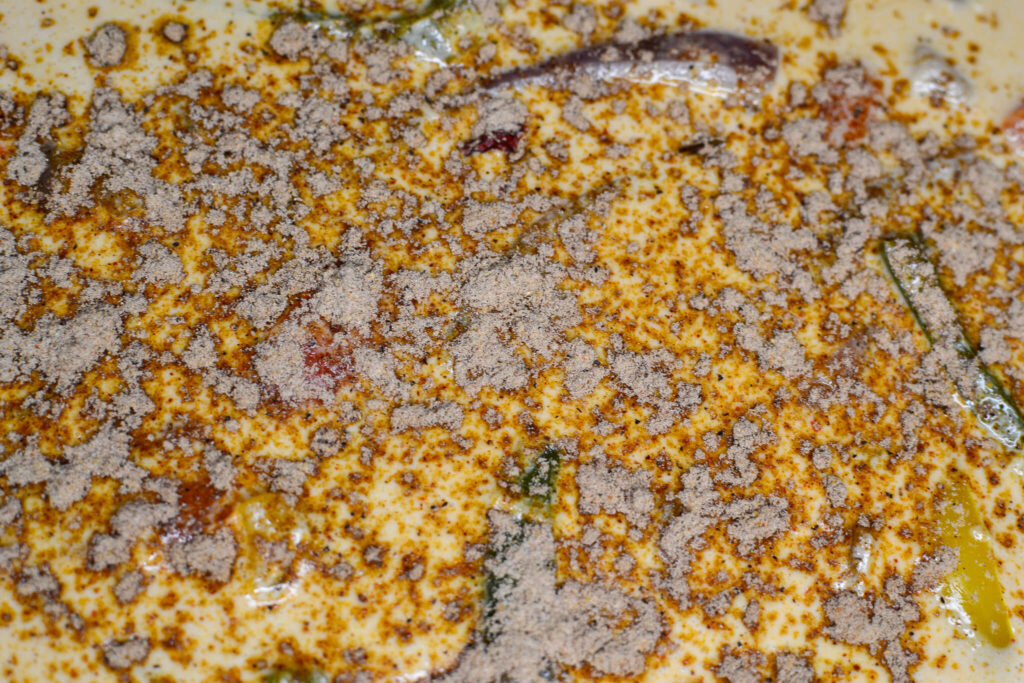
If you find that your sauce needs a bit more flavor, don’t hesitate to adjust it to your taste. A simple and effective way to enhance the sauce is by adding a bit more fajita seasoning. Sprinkle in the seasoning gradually, tasting as you go, until you reach the desired flavor profile. This extra seasoning can really make the flavors pop and ensures that your sauce perfectly complements the other components of the dish. Remember, cooking is all about personalizing the flavors to suit your palate, so feel free to tweak the seasoning to get it just right.
Step 4
Combine Steak & Pasta
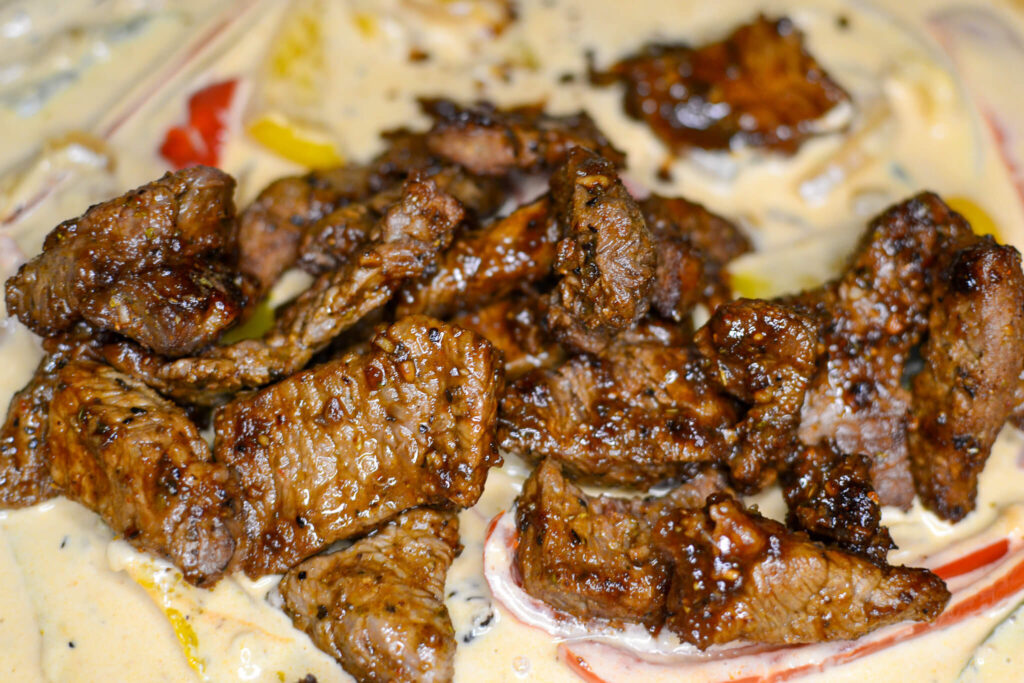
Now it’s time to add the steak. Cut the rested steak into thin strips and mix them into the pasta. Be gentle to just heat the steak without overcooking it, keeping it tender and juicy.
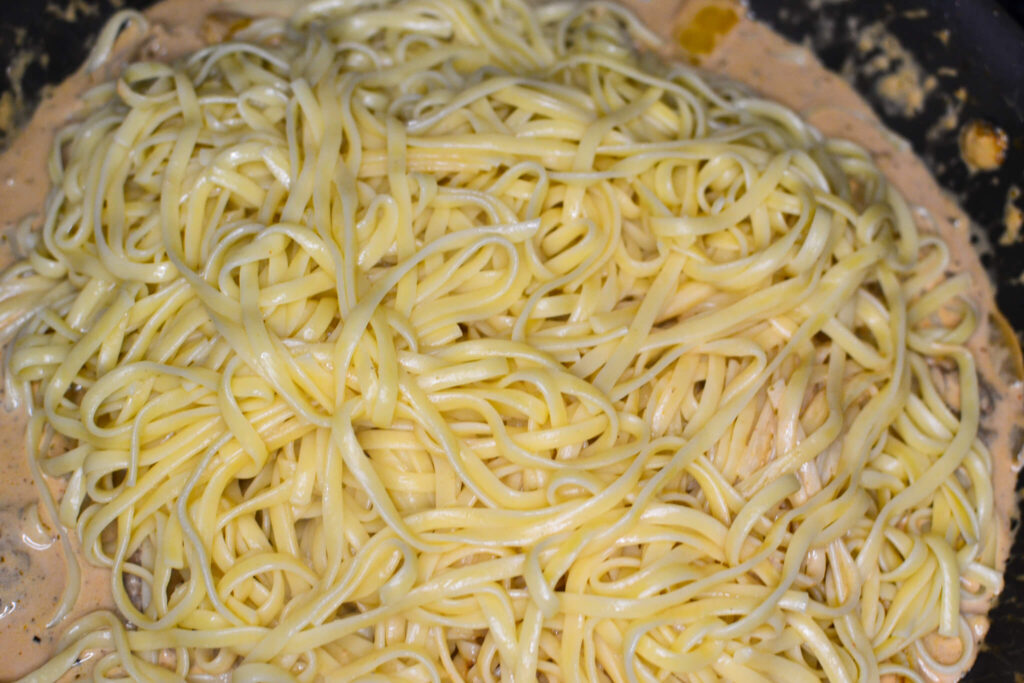
Now, bring all the elements together. Put the cooked pasta into the sauce so it absorbs the creamy mixture. Stir everything gently to make sure the pasta is evenly coated with the sauce.
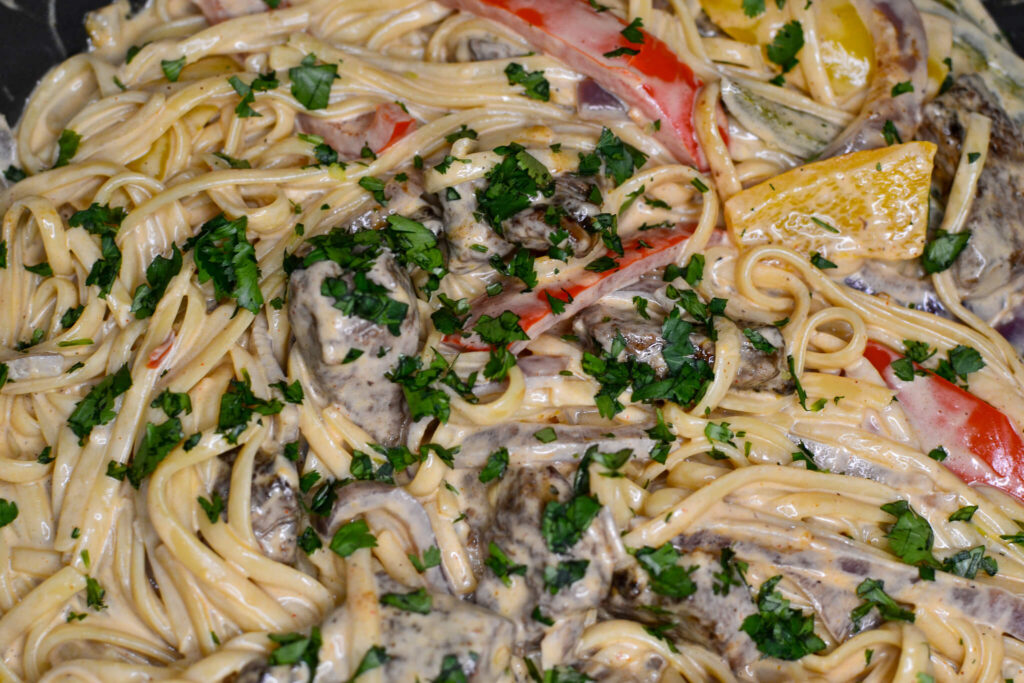
Just before serving, consider adding a final touch to elevate the flavors further. Sprinkling a handful of fresh cilantro over the contents in the pan introduces a vibrant pop of color and a burst of fresh, herby brightness. For those who enjoy a hint of zest, a squeeze of lime juice can be a delightful addition. The lime juice adds a tangy twist, cutting through the richness of the dish and balancing the flavors beautifully. These optional steps can transform the dish, adding layers of flavor that make each bite even more enjoyable.
For an extra burst of flavor, you might want to consider adding diced tomatoes. They pair wonderfully with the zesty lime and the refreshing cilantro, offering a delicious enhancement to your dish.
Step 5
Enjoy Your Steak Fajita Pasta!

Plate the steak fajita pasta, ensuring a good mix of the tender steak, creamy pasta, creamy sauce, and crisp vegetables on the plate. Finish it off with a garnish of fresh cilantro for extra flavor and color.
Enjoy!

Dallas Buyers Club

Inspiration
“Relax, Smell The Steak” – Ron Woodroof

More About Steak Fajita Pasta
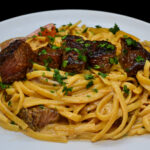
Steak Fajita Pasta
Ingredients
- 2 Ribeye Steaks
- 1 packet Fajita Seasoning Pre-mixed, such as McCormick
- 1 tbsp Olive Oil
- 1 Green Pepper
- Yellow Pepper
- Red Pepper
- Sweet Onion
- Garlic Cloves
- 7 oz Chipotle Peppers
- 1/2 cup Chicken Broth
- 16 oz Linguine Pasta
- 1 cup Heavy Cream
- 4 oz Cream Cheese
- Fresh Cilantro
- 1/2 tsp Salt
- 1/2 tsp Black Pepper
- 1 Lime
- 2 Tomatoes
Instructions
- Thinly slice the ribeye steaks against the grain for maximum tenderness.
- In a mixing bowl, combine the fajita seasoning with olive oil. Add the sliced steak and toss to coat evenly. Let marinate for at least 30 minutes in the refrigerator.
- Heat a large skillet over medium-high heat. Sear the marinated steak strips until browned and cooked to your desired doneness. Remove from skillet and set aside to rest.
- Thinly slice the green, yellow, and red peppers, as well as the sweet onion. Mince the garlic cloves.
- In the same skillet, add a little more olive oil if needed. Sauté the peppers, onions, and garlic over medium-high heat until softened and slightly caramelized, about 10 minutes. Season with additional fajita seasoning, salt, and pepper to taste.
- Bring a pot of salted water to a boil. Add the linguine and cook according to package instructions until al dente. Drain and set aside.
- In the skillet with the sautéed veggies, pour in the chicken broth to deglaze, scraping up any browned bits from the bottom.
- Reduce heat to medium-low. Stir in the heavy cream and softened cream cheese, mixing until smooth and creamy.
- Add the chipotle peppers in adobo sauce to the sauce. Stir well to combine, adjusting the amount based on your desired level of smokiness and heat. Season with additional salt and pepper if needed.
- Add the cooked linguine to the creamy sauce, tossing to coat the pasta evenly.
- Gently fold in the seared steak strips, ensuring they are heated through without overcooking.
- Add diced tomatoes and fresh cilantro. Drizzle with lime juice for a fresh, tangy flavor boost.
- Serve the Steak Fajita Pasta warm, garnished with additional fresh cilantro and lime wedges if desired.
This recipe is a modern fusion dish that combines the flavors and ingredients of fajitas and pasta. Fajitas are a traditional Tex-Mex dish made with grilled or seared meat, typically skirt steak, that is seasoned with a blend of spices and served with sautéed onions and peppers on a warm tortilla.
Pasta, on the other hand, is a staple food in Italian cuisine that is typically made from wheat flour and served with a variety of sauces and toppings.
The exact origin of this dish is unclear, but it likely emerged in the United States in the 20th century as a result of the growing popularity of Tex-Mex and fusion cuisine.

